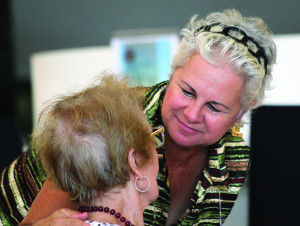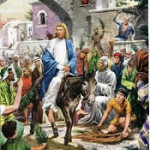This month’s class had two distinct sections: liturgy of the hours in the monastic tradition (taught by Sister Mary Lou) and lectio divina (taught by Jacquelyn (a completed oblate)).
As always, our meeting began with evening prayer with the sisters. Since it was St. Patrick’s Day, we sang a version of St. Patrick’s Breastplate to the tune of a traditional Gaelic melody that many of us would know as “Morning has Broken.” We all had Cat Stevens in our minds as we when to class.
Liturgy of the House
We have participated in the prayer of the hours since the beginning of our oblate formation, and any time we come to the monastery for prayer. Also, many of us candidates have been working on praying the hours outside of our time at the monastery. Sister Mary Lou gave us the structure and some of the meaning.
Structure
The structure is fairly simple, probably because this is a time of prayer, not a full mass or worship service, but each major element may have several smaller elements within it.
- Call to Worship – Ours begins with “O God come to our assistance . . .” and I actually haven’t caught on to the whole phrasing yet. We bow during this.
- Hymn – One song sung, then the hymnbooks are put away.
- Antiphon – This is a short sentence that is recited together and will be repeated at various times throughout the time of prayer.
- Psalm – One or two psalms are read together. In the monastery we have two chorus (seating groupings that face each other), and we trade off reading verses or reading together.
- Antiphon (repeated)
- Reading – Another selection of Scripture is read together in the same manner as the psalm.
- Antiphon (repeated)
- Canticle – For us this is typically a reading from The Rule of St. Benedict
- Magnificat – This is basically a closing song based on the Magnificat, and there are many variations.
- Intercessions – This is usually prayed by a leader and then goes directly into The Lord’s Prayer.
- The Lord’s Prayer – Said in unison
- Oration of the Day – This is a short closing prayer with a trinitarian ending, spoken by a leader, which then leads directly into the blessing.
- Blessing – The blessing we typically use is:
Leader: May God grand us a peaceful night.
All: And a perfect end.
- Blessing – The blessing we typically use is:
 Although this is a long list, it only takes about 30 minutes to complete. With only five major areas, to me, this should not seem especially complicated, but it can be very tricky in practice. The type of book used for prayer may have from two to six bookmarks in it. The majority of the pages in a prayer book contain the prayers for each day over five weeks. Magnificats may all be in the back. Depending on the book, readings for the day, or an index for the readings, will also be in different sections. When in any season besides ordinary time, the antiphons many be different, so one has to know where to look for those alternate pieces as well.
Although this is a long list, it only takes about 30 minutes to complete. With only five major areas, to me, this should not seem especially complicated, but it can be very tricky in practice. The type of book used for prayer may have from two to six bookmarks in it. The majority of the pages in a prayer book contain the prayers for each day over five weeks. Magnificats may all be in the back. Depending on the book, readings for the day, or an index for the readings, will also be in different sections. When in any season besides ordinary time, the antiphons many be different, so one has to know where to look for those alternate pieces as well.
There are free apps and websites easily found for praying the hours, but as with the books, they are not all necessarily easy to navigate. As with the various books, the various apps and websites may not only have distinct navigation, but also varied readings.
After eight months I feel I am just starting to get the hang of it. I participated in evening prayer before a class on death and life earlier in March. I looked at the book before we began, and knew exactly where I was supposed to be. Then my phone alarm went off (to remind me to go to prayer) just before the chapel bell was rung. Shuffling with my phone distracted me, and I needed assistance finding my place twice during prayer. However, at the night of this class on prayer and lectio I was able to help others find their place, and the following day at Taizé prayer I was asked to read the Scripture.
Meaning
All the elements listed above, including songs and readings, are prayer. In my congregation’s order of service, we list every element as a part of worship (worship in: prayer, song, proclamation, fellowship, offering, or sacrament). The Benedictine way would be to list every element as a part of prayer. We specifically pray the Psalms because their range of emotion allows us to learn to speak honestly in our prayers.
 Benedict considered prayer essential, devoting chapters 8-24 of his rule to prayer, but the Liturgy of the Hours is not only a monastic, Roman Catholic, or high church form. It is a means of praying together with all the saints. Still, the Liturgy of the Hours “holds us to the wheel of monasticism,” and like exercise, we will not make time for prayer until we convince ourselves that prayer is important.
Benedict considered prayer essential, devoting chapters 8-24 of his rule to prayer, but the Liturgy of the Hours is not only a monastic, Roman Catholic, or high church form. It is a means of praying together with all the saints. Still, the Liturgy of the Hours “holds us to the wheel of monasticism,” and like exercise, we will not make time for prayer until we convince ourselves that prayer is important.
Lectio Divina
Teachers and books introduced me to lectio divina several years before I began oblate formation. At Wesley Seminary at IWU, Dr. Luchetti, taught us lectio as part of sermon preparation, although he didn’t use the term lectio. I find prayerful meditation to be the greatest time portion of my preparation, and the more time I spend in meditation the more quickly I can write the text. I also participate in the weekly lectio through Seattle Pacific University. Lastly, I have Sister Meg Funk’s book Lectio Matters.
 Lectio Divina is a contemplative way to listen to God in prayer with the Scriptures. It is done slowly and quietly. A passage is read multiple times during a lectio prayer, and sometimes the same passage is often continued in lectio until one has the sense that God has finished speaking. The form of lectio has five parts:
Lectio Divina is a contemplative way to listen to God in prayer with the Scriptures. It is done slowly and quietly. A passage is read multiple times during a lectio prayer, and sometimes the same passage is often continued in lectio until one has the sense that God has finished speaking. The form of lectio has five parts:
- lectio – Select a Scripture passage for prayer, and read it 1 – 3 times with a listening heart.
- meditatio – Ponder the Word, being aware of images and words of note, and listening for the meaning in one’s life.
- oratio – Speak to God about the parts that were of note to you. This is one’s assent and response to the Word.
- contemplatio – Take time for silence and rest in the Word, not wondering what one will do with the illumination, but rather listening for what God would have one become.
- compassio – Go forth to live the Word.
We used Luke 19:28-40, the triumphal entry of Jesus, for our lectio passage for the evening. As I had been working through that passage in preparation for Sunday, I welcomed taking more time with it. Even though I had been in that passage for a couple of weeks, I gained new insights both from my meditation and from hearing the reflections of others.
Even though I use lectio for sermon preparation, which should also be formation for the preacher, lectio is not about study, but listening. It is not about doing, but becoming. It is not about knowledge, but relationship.
Action Plan/Goals
These goals are not necessarily new. I find myself at this point wanting to improve in areas I have already begun.
- Continue to work to make prayer the pulse of my day with morning, mid-day, and evening prayer.
- Continue to improve in my use of lectio as part of my sermon preparation.
- Make prayer the pulse of the Oakdale Wesleyan Church congregation.
The next course is Spirituality of Work.
photo credit: Puzzling-2683 via photopin (license)
photo credit: MEC Toronto Race Two The Waterfront Flyer 5K 10K 15K 2015 via photopin (license)
photo credit: IMG_4554 via photopin (license)






